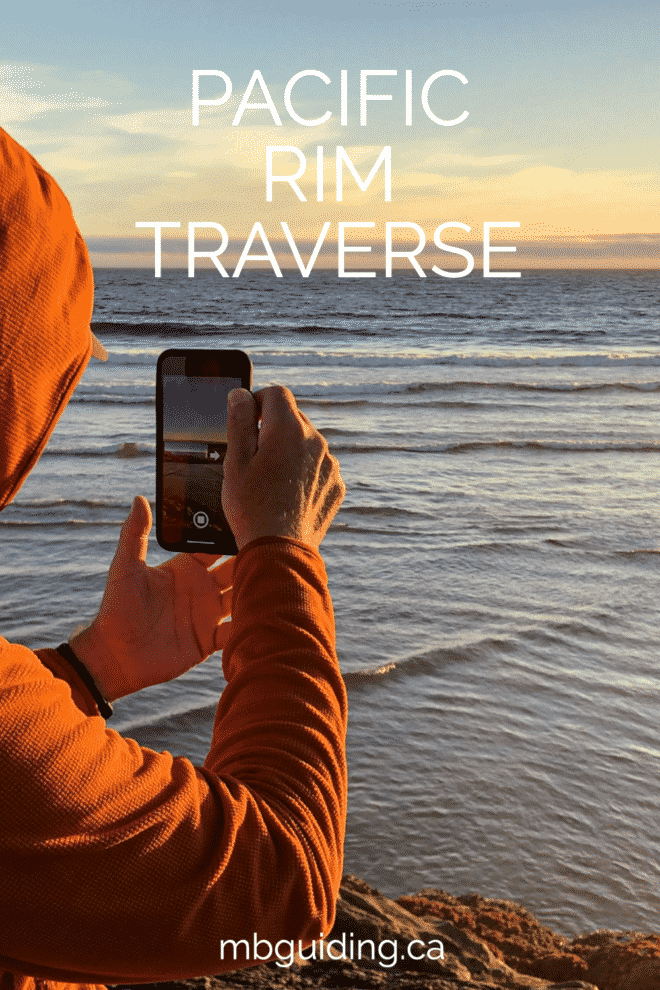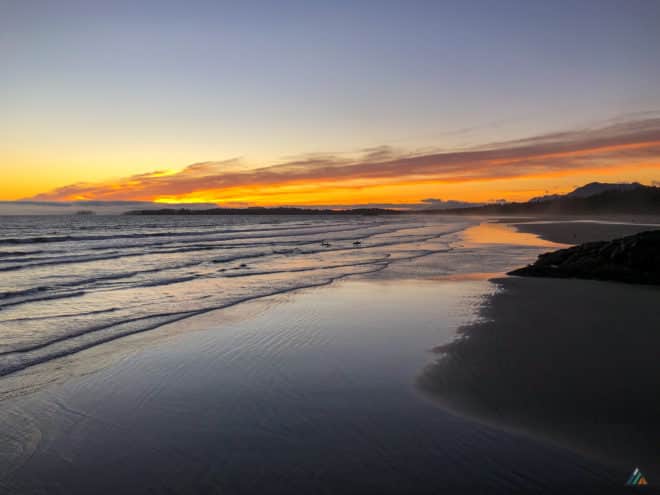
The Pacific Rim Traverse is a 22 km beach hike in Pacific Rim National Park. Highlights include epic coastal views and rich marine wildlife.
This spectacular oceanfront route stretches between Wya Point and Portland Point. Approximately 20 km of the hike is on hard, flat, sand beach. There are a couple of short sections of single track and boardwalk. Including a 2 km rainforest and bog section to bypass the rocky headlands at Quisitis Point. Our recommendation is to camp at Green Point and hike the traverse in two sections over a couple of days. The Pacific Rim Traverse is a perfect trip for hikers looking to experience a world-class coastal environment with all the comforts of vehicle-accessible camping or full-service resorts nearby. It is also a great introduction to coastal hiking and camping for anyone considering bigger trips like the West Coast Trail, North Coast Trail, and Nootka Trail.
Permits Required

All visitors to Pacific Rim National Park Reserve require a National Park Entry Pass. As of January 1, 2018, admission to Parks Canada places for youth 17 and under is free. Everyone else is required to pay an admission fee.
Driving Directions
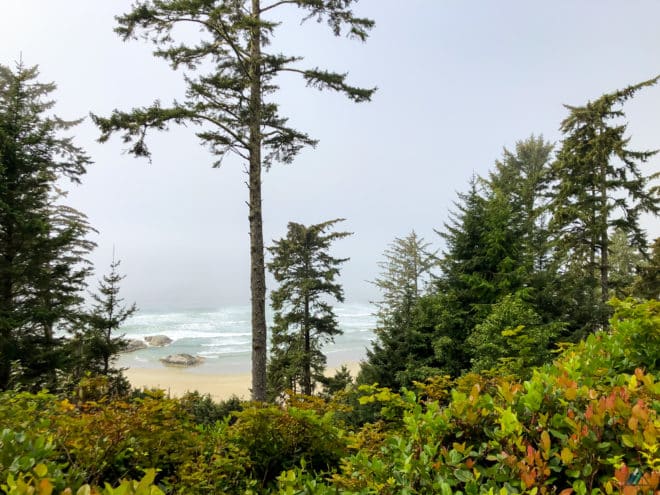
The Pacific Rim Traverse is located in the Long Beach Unit of Pacific Rim National Park Reserve. The Green Point Campground makes an excellent staging area. Tofino is 20.3 km northwest and Ucluelet is 20.0 km southeast. Google Map
Camping Options

There is no backcountry camping permitted in the Long Beach Unit of Pacific Rim National Park Reserve. If you want to hike the Pacific Rim Traverse and camp overnight, we recommend staying at Green Point. Green Point Campground is the only campground in the Long Beach Unit. 94 drive-in sites, with electrical service, flush toilets, showers, fire-pits, picnic tables, sani-dump. 20 walk-in forest sites, unserviced, flush toilets, fire-pits, cold water taps, picnic tables, food storage. 1 group walk-in site and 1 oTENTik soft sided tent on a platform. All sites have firewood available for a fee. Reservations can be made at Parks Canada Reservation Service or by calling 1-877-737-3783.
Trip Reports

- Kiwisitis Beach to Schooner Cove – August 31-September 1, 2020
- Green Point to Schooner Cove – June 1, 2019
- Long Beach to Schooner Cove – June 20, 2018
- Florencia Bay to Schooner Cove – May 15-16, 2018
Kiwisitis Beach to Schooner Cove – August 31-September 1, 2020
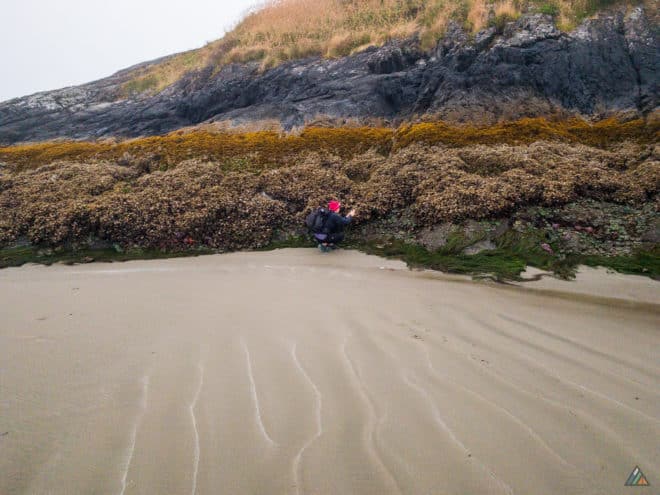
- Distance: 31.8 km
- Duration: 2 days
- Peak: 49 m
- Gain: 120 m
- Route: CalTopo
Pacific Rim National Park is a beautiful place that we visit as often as possible. For late summer 2020, we had the opportunity to complete the Pacific Rim Traverse over two days. The full 22 km coastal route, as we define it between Wya Point and Portland Point, can be hiked in a single day. However, as we were camping at Green Point and only had one vehicle, we opted for a modified plan. We hiked out and back over two days from Green Point to Kiwisitis Beach and Green Point Point to Schooner Cove, doubling the highlights along the route.
Weather
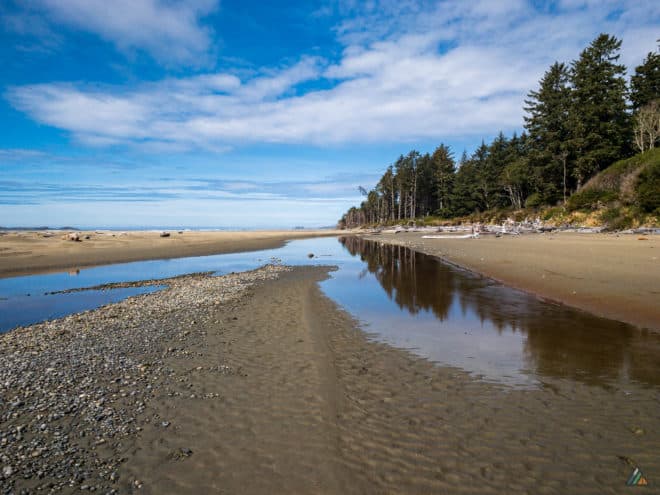
The forecast called for a strengthening ridge of high pressure. Day 1 was perfect with minimal cloud cover and nice hiking temperatures. Day 2 was foggy throughout the day until late in the afternoon when it all burned off with clear skies for sunset.
- Day 1: 0900 h, Green Point Campground. Elevation: 46 m, Sky: scattered clouds, Precipitation: nil, Temperature: 12.9°C, Humidity: 91.6%, Wind: calm, Pressure: 1021.0 mb. 1500 h, Sandhill Creek. Elevation: 5 m, Sky: few clouds, Precipitation: nil, Temperature: 20.1°C, Humidity: 60.2%, Wind: calm, Pressure: 1021.9 mb.
- Day 2: 0500 h, Green Point Campground. Elevation: 46 m, Sky: obscured, Precipitation: nil, Temperature: 14.4°C, Humidity: 73.3%, Wind: calm, Pressure: 1021.6 mb. 1000 h, Long Beach. Elevation: 5 m, Sky: obscured, Precipitation: nil, Temperature: 16.5°C, Humidity: 83.6%, Wind: calm, Pressure: 1022.5 mb.
Route
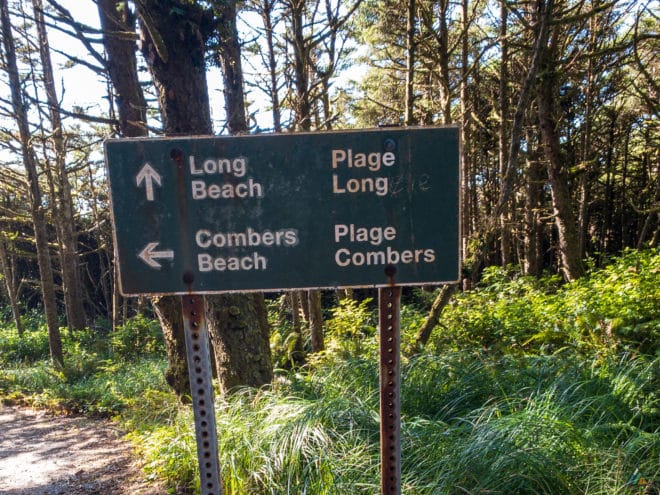
The Pacific Rim Traverse is an excellent experience for all levels of coastal hiker. The beach sections offer flat packed sand, creek crossings, sand dunes, and rocky headlands. Access to the beach is via parking lots, the Green Point Campground trails, or other park rainforest trails. We have completed sections of this route many times before, and we never tire of the wonderful scenery.
On Day 1, we hiked from Green Point Campground to Kiwisitis Beach (just southeast of the Kiwisitis Visitor Centre). Our modified objective was South Beach versus Wya Point. The weather was spectacular, so we took an extended break at Sandhill Creek for a bird bath. Wickaninnish Beach was busy with surfers and picnickers, and the Visitor Centre was closed. On our way to South Beach, the trail was blocked due to COVID-19 regulations. We backtracked to a pocket beach and found some shade for an extended lunch. Fed and rested, we hiked back to camp in one push…except for another short break at our favourite Sandhill Creek.
On Day 2, we took advantage of low tide to see the intertidal animals of Schooner Cove. We rose at 0400 h and started hiking in the fog at 0500h. There wasn’t much to see until Lovekin Rock came into view. We checked out the starfish and sea anemones encrusting the base of this landmark. There were very few other people out, just a few surfers. After passing Box Island, we had the Schooner Cove zone to ourselves. Our early push gave us the opportunity to explore the rocky structures normally submerged. The concentration of wildlife was astonishing. We did not make it all the way to Portland Point as the tide had started to rise. As we didn’t fancy getting trapped, we took our break on a safe rocky viewpoint and turned around. We hiked back to Green Point, this time walking adjacent to the sand dunes looking for flowers. Instead of heading straight to camp, we rested on comfy beach chairs that we had carried all morning.
- Day 1: Green Point to Kiwisitis Beach. Distance: 15.02 km, Duration: 5:18’35, Ascent 60 m, Ascent Time: 0:22’05, Descent: 56 m, Descent Time: 0:18’43. Suunto
- Day 2: Green Point to Schooner Cove. Distance: 17.09 km, Duration: 5:07’02, Ascent 53 m, Ascent Time: 0:18’56, Descent: 49 m, Descent Time: 0:14’50. Suunto
Data logged with Suunto 9 Baro
Wildlife
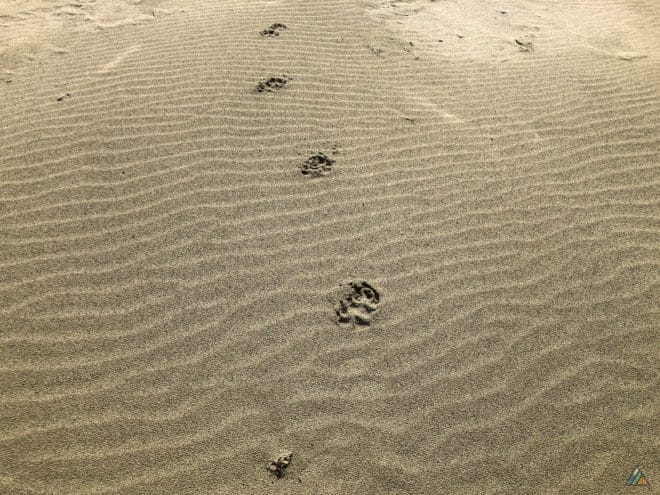
No mega fauna viewed on this trip. We did see wolf sign in the dunes by Sandhill Creek. We saw the usual assortment of intertidal invertebrates: purple sea stars, ochre sea stars, hermit crabs, barnacles, and mussels. Tide pools were also full of small fish, such as sculpins. Birds were around as always: seagulls, ravens, crows, eagles, hummingbirds, and robins.
Hazards
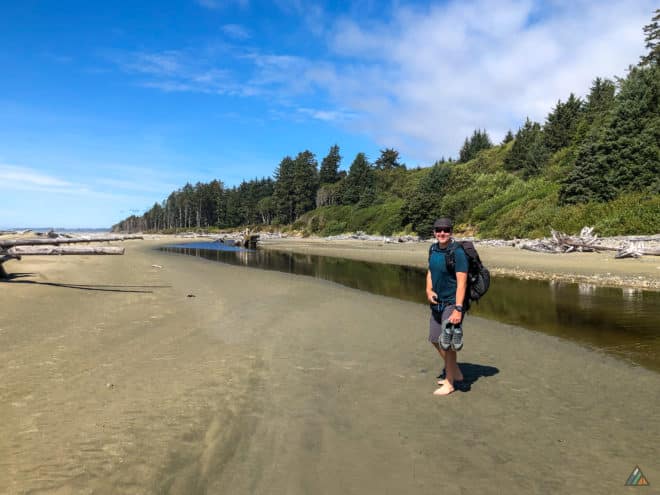
We are always mindful of the coastal hazards when hiking in Pacific Rim National Park. Pay attention to changing tides, sudden beach flooding, moving logs, tidal creeks, surge channels, rip currents, rogue waves, and tsunamis. Check out Coast Smart for more information on coastal hazards. We also carry lots of fresh drinking water, and wear sun hats, sunglasses, and sunscreen.
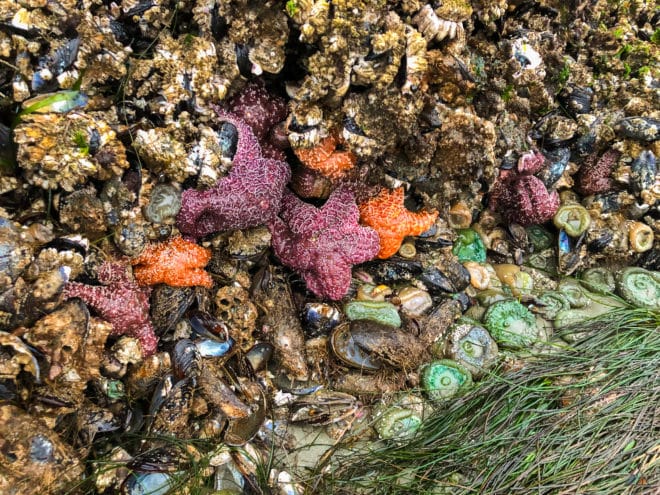
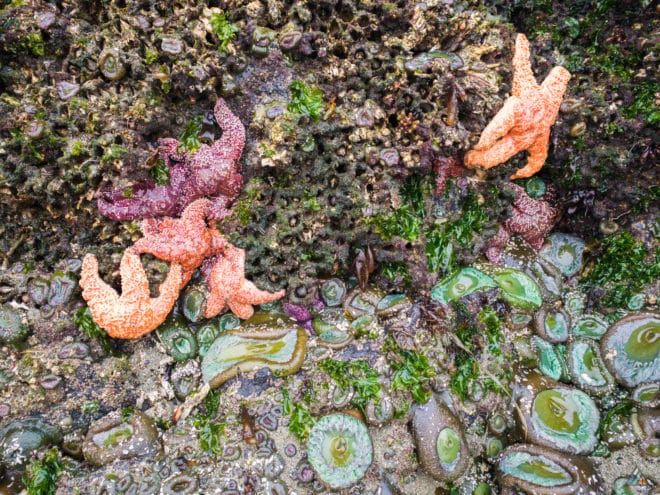
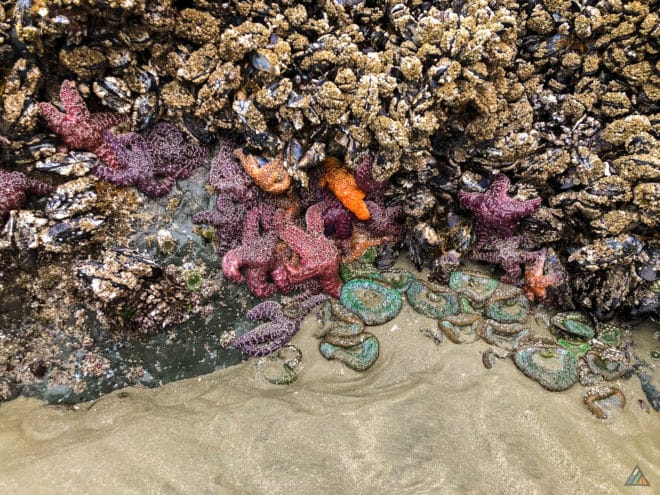
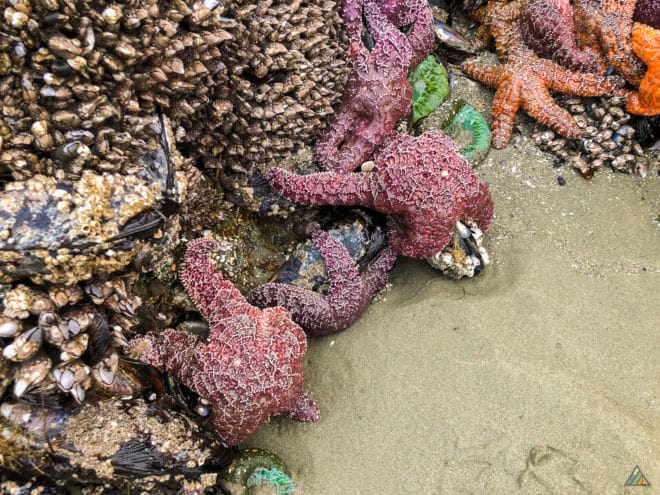
Green Point to Schooner Cove – June 1, 2019
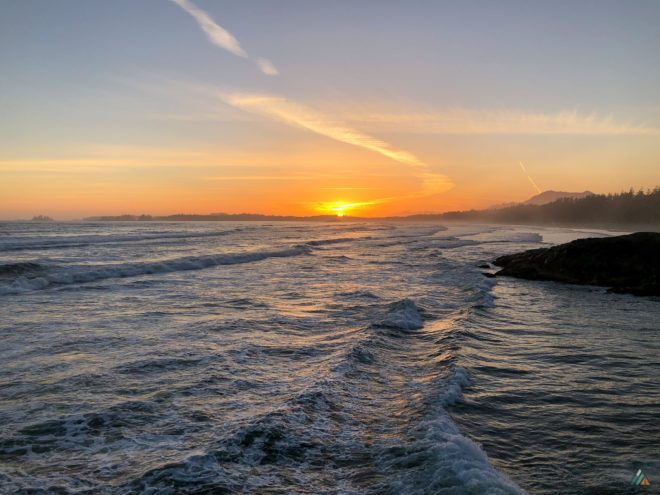
- Distance: 15.6 km
- Duration: 6 h 26 min
- Peak: 9 m
- Gain: 9 m
- Track: Suunto
The sandy beaches of Pacific Rim National Park are world class, but the intertidal zone is where you find an astonishing concentration of plants and animals. On June 1, 2019, low tide was 0.62 metres at 0616 h. Parks Canada’s publication Exploring the Seashore suggests that tide pool viewing and beach hiking are best when tide levels fall below 1.5 metres. Because our objective was a marine biology extravaganza, our alarm clock at Green Point Campsite was set for 0400 h! We woke in the dark and hiked to the beach with reasonable organization. The birds were already awake and singing from the trees. Fog kept the beach scene soft and grey. Our feet hit the sand at 0500 h and we hiked west along Long Beach. Familiar Lovekin Rock, a tiny off-shore island, grew larger in our view. By the time we got to the base, the tide was low enough to expose the intertidal ecosystem. Lovekin Rock did not look easy to climb. The lower base is steep and slick with seaweed, algae, and marine animals. The beach was still deserted as we passed by Incinerator Rock, hiked through the low creek draining out of Esowista, and rounded Box Island to arrive at Schooner Cove. The rain forest trails from the Schooner Parking Lot were closed for maintenance, so we continued on as the only humans around. Once in Schooner Cove, we explored the rocky formations and tide pools for marine life. This shoreline wildlife viewing is the best we have seen anytime, on any trip. Crazy clusters of purple sea stars, ochre sea stars, green sea anemones, California mussels, rockweed, chitons, limpets, and barnacles covered every centimetre of rock below the tide line. Hermit crabs and tide pool sculpins moved about the pools. The tide was on its way in, so we didn’t make it west to Portland Point. We like to save an objective for another day so there is additional motivation to come back. After eating early lunch, we hiked back alongside the sand dunes. We saw delicate crawling beach morning glory and purple sea pea among the bleached logs. Places like Schooner Cove can be visited multiple times a year. The beach, the landscape, and the animals are always changing with the seasons. Check guides available at park information centres for Tofino tidal predictions and safety notices. It was worth the temporary discomfort to rise early and observe such spectacular marine biology.
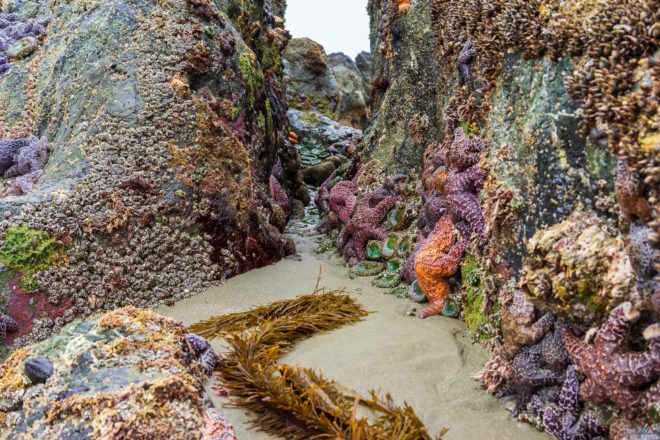

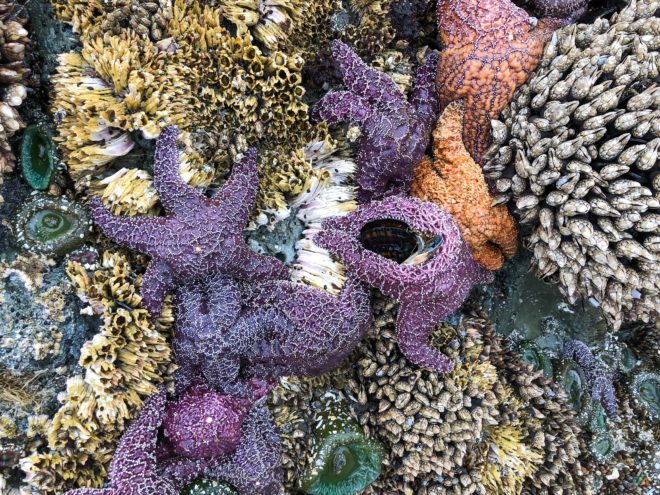
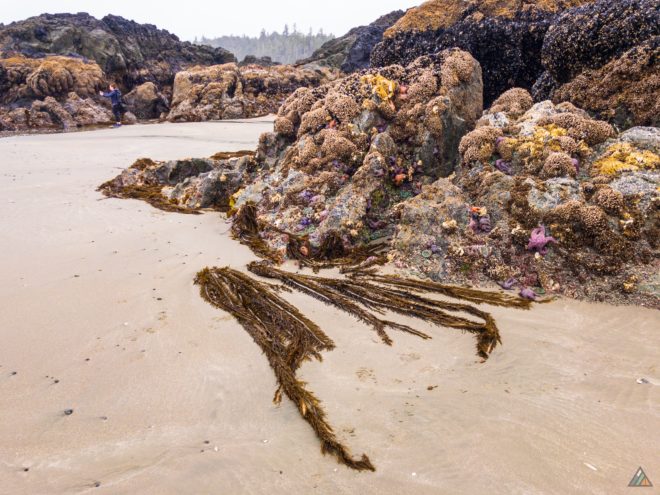
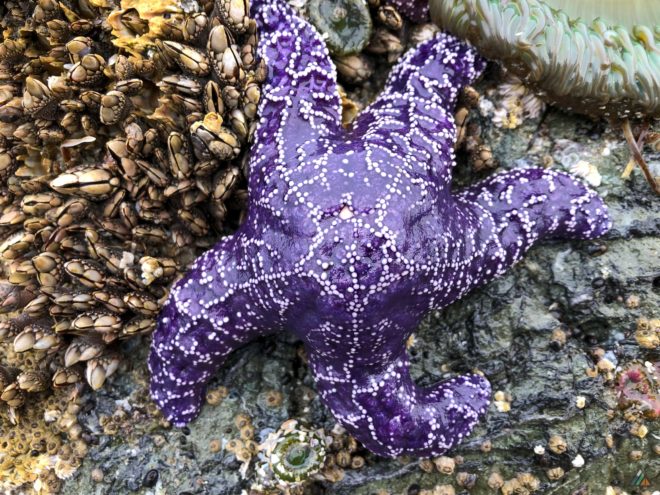
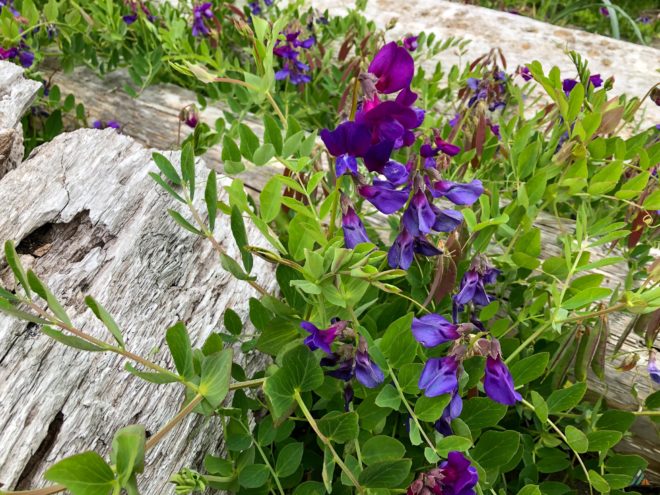
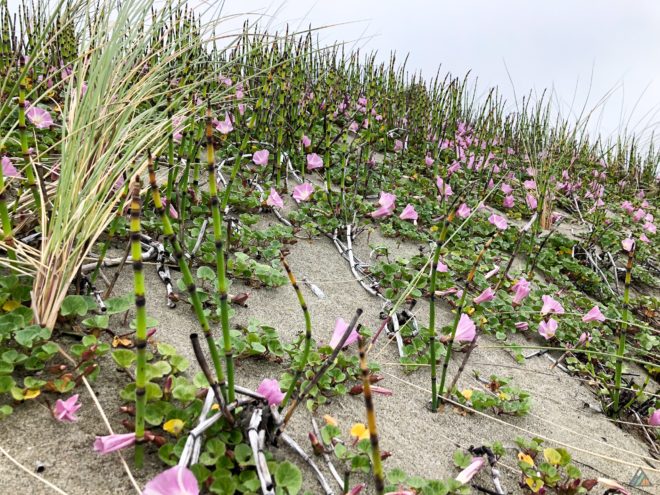
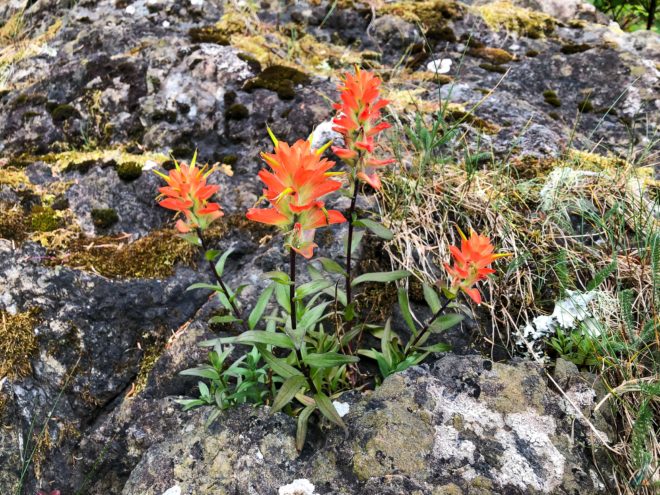
Long Beach to Schooner Cove – June 20, 2018
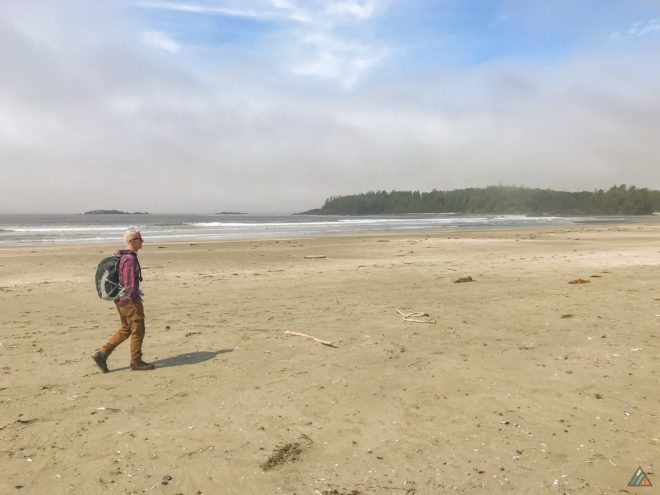
- Distance: 12.3 km
- Duration: 6 h 2 min
- Peak: 17 m
- Gain: 33 m
- Route: CalTopo
Our guests were keen to check out new hiking terrain in Pacific Rim National Park Reserve. The hike from Long Beach to Schooner Cove is always a favourite. We timed our hike on the low tides to maximize marine wildlife viewing in the intertidal zones. We started our hike from Beach Access 1 in the Long Beach Parking Lot. The hot sun was rising high above and already strong enough to burn off the fog and low clouds. We hiked northwest along the hard sand towards Incinerator Rock and Esowista. We crossed a small creek and headed towards Box Island. Exploring the rainforest shoreline and viewing eagles flying about. Several small surge channels were dry enough to walk into and see the sea life tucked away in the rocks up close. Bluing skies and warm temperatures greated us around the point into Schooner Cove. Summer was here! We spent many hours rambling about and viewing all the amazing marine wildlife. We only saw a few other hikers out here all day. A bit of easy scrambling onto Portland Point rewarded us with an epic view. We could see most of our route and the massive stretch of sand that the Long Beach Unit is world famous for. We arrived at the surge channel and decided it was time to retrace our steps. We hiked our way back around Schooner Cove and onto Long Beach where we started. Many more wildlife viewing opportunities presented themselves. This zone is full of surprises and although we didn’t catch a glimpse of a whale or a wolf we knew they were always close by!
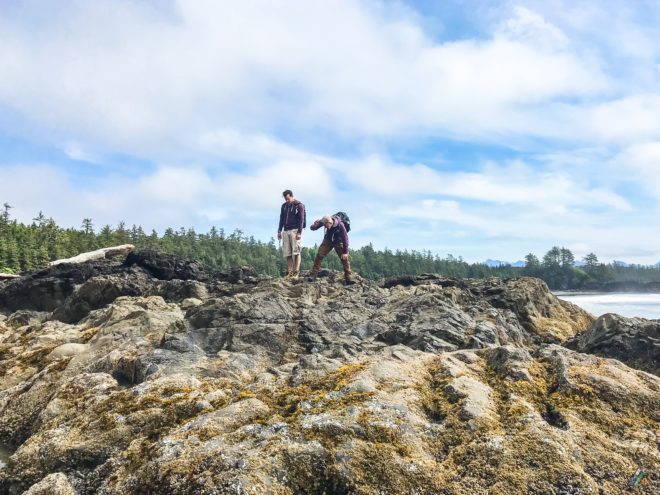
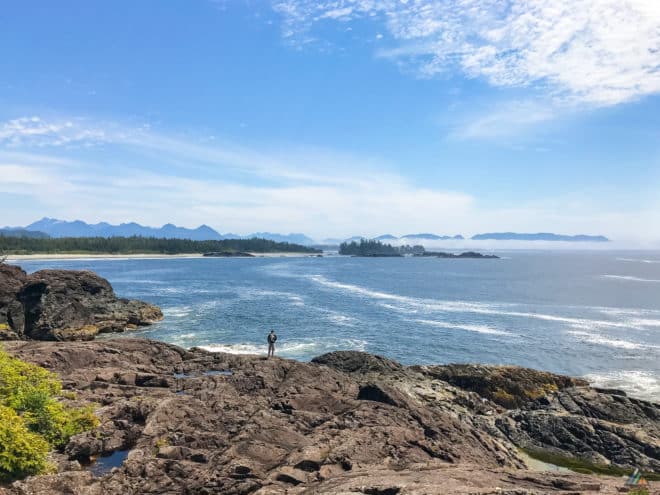
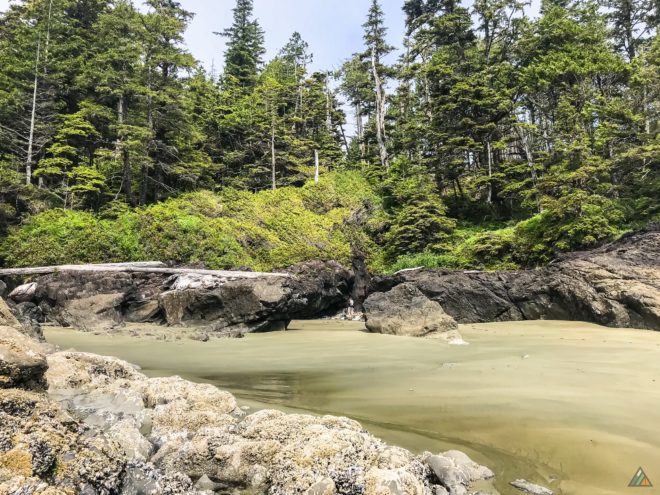
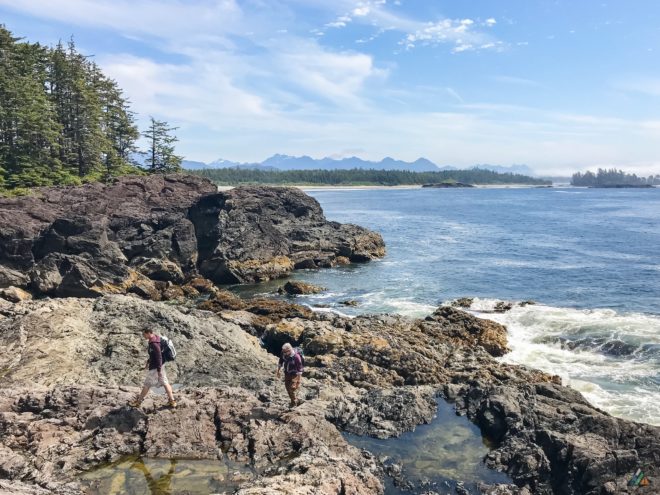
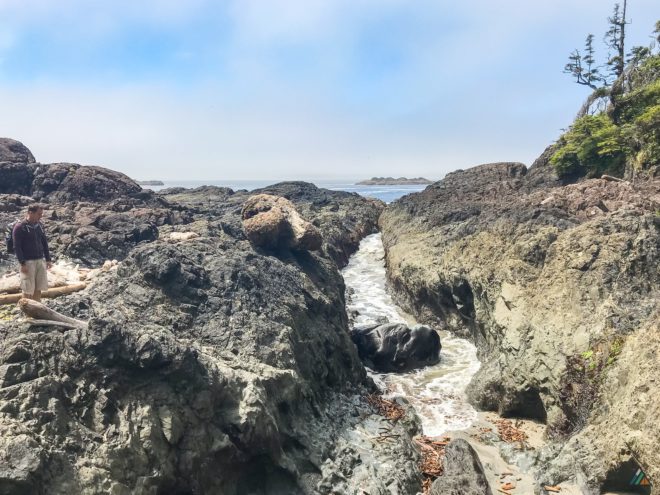
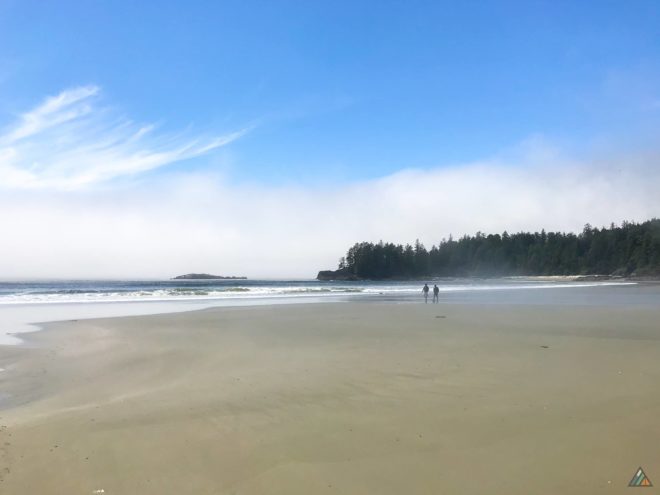
Florencia Bay to Schooner Cove – May 15-16, 2018
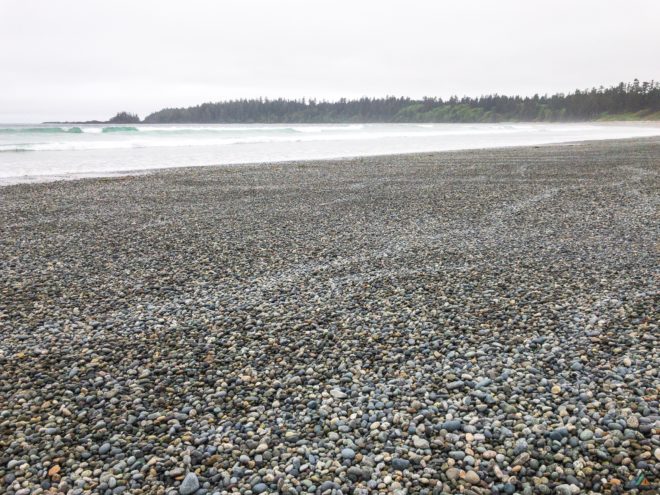
- Distance: 29.3 km
- Duration: 2 days
- Peak: 51 m
- Gain: 197 m
- Route: CalTopo
This was our first time trying to connect the Long Beach Unit hikes that we’ve been exploring for decades. During our two days of hiking we were lucky to have long sections of beach to ourselves for hours at a time. We planned our hikes to coincide with very low morning tides. Thousands of anemones and hundreds of starfish in remote tide pools and hidden sea caves! A highlight was stopping for a break at South Beach and having two whales join us within 100 m of the coastline. Staging at Green Point gave us an opportunity to learn and practice camping skills while enjoying the amenities of a five star drive-in campground. We utilized two vehicles for a shuttle and hiked the traverse in two sections. First section was northbound from Florencia Bay to Green Point. Second section was southbound from Schooner Cove back to Green Point. We learned and practiced coastal hiking skills both days.
Day 1: Florencia Bay to Green Point

- Distance: 15.7 km
- Duration: 6 h 22 min
- Peak: 51 m
- Gain: 106 m
We woke up early and had a quick breakfast and coffee. We then drove one of our vehicles to the Willowbrae Trail parking lot. After a 1.5 km jaunt through the forest and a few flights of stairs, we arrived at the southeast side of Florencia Bay. It’s easy hiking on hard sand and some pebble sections to Lost Shoe Creek. We crossed the creek practicing safe fording technique and managed to keep our shoes dry. There’s a long flight of stairs to the top of the sand cliffs above Florencia Bay. Once on top, check out the viewing platform and plaque commemorating the wreck of the Florencia. There’s a nice a boardwalk and interpretive trail through the rainforest and bog on the way to Kwisitis Visitor Centre. It’s worth a stop at South Beach to check out the view, rock formations, and wildlife. We saw the two whales there! Hiking northbound from the Kwisitis Visitor Centre, the next beaches are Wickaninnish and Combers. We rarely see people and often see wolf tracks around the mouth of Sandhill Creek. After an easy ford on low tide, it’s a couple more kilometres to Green Point.
Day 2: Schooner Cove to Green Point
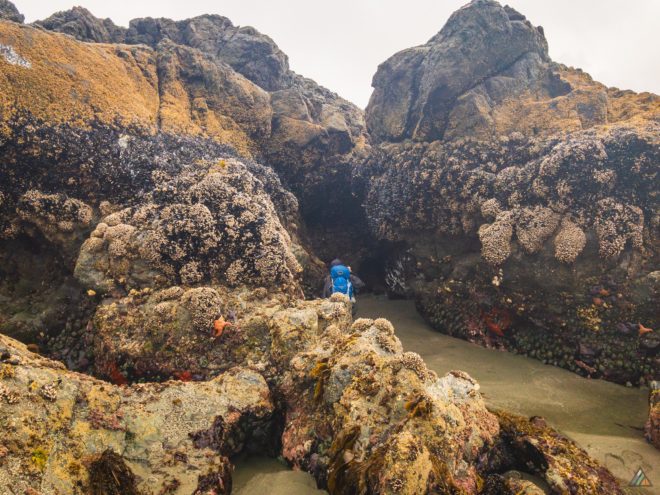
- Distance: 13.6 km
- Duration: 5 h 55 min
- Peak: 43 m
- Gain: 91 m
We followed a similar plan the next day, waking up early and packing up camp. We checked out and left a vehicle at the Green Point Campground entrance parking lot. Then shuttled up to the Schooner Cove Trail parking lot. The first section of trail follows a boardwalk through the rainforest out to the northwest end of Long Beach. We yo-yoed the section from here out to Portland Point and then travelled southeast to complete our hike at Green Point. If you time the tides right, and hike further northwest between the point and Box Island, you’ll be rewarded with an expansive and seldom visited hard sand beach that stretches all the way towards Portland Point. We timed the tides right! Make sure to leave at least three hours to fully explore Schooner Cove and the rocky headland at Portland Point. The best part about visiting the cove on a low tide is viewing the insane amount of sea life in the intertidal rocks. Less people typically means more wildlife. Be prepared for all possible wildlife encounters and Keep the “wild” in wildlife.
